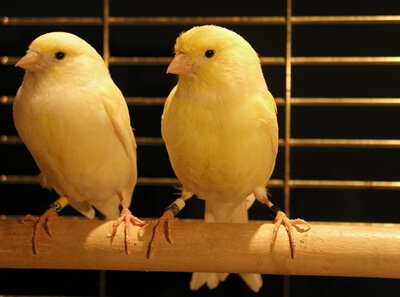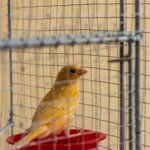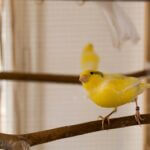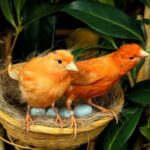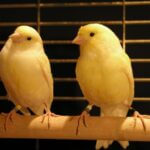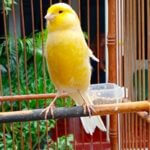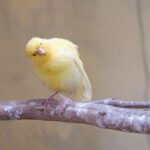To breed canaries, knowing when they’re ready to mate is essential.
Although the courting behaviors are distinct, they can be mistaken for other habits. For example, you may think your canary is behaving aggressively when he’s preening or mounting the female.
To enable you to understand when your canaries are ready to breed and how to encourage this, we’ll explore the different mating rituals they perform:
How Can I Tell If My Canaries Are Ready To Mate?
When canary owners start breeding their pets, it’s natural to have difficulties recognizing the signs of courtship. After all, some behaviors displayed (especially by male birds) appear aggressive, not flirtatious.
The key is to watch the body language and general tone of the interactions between the male and female canaries. If you do, you’ll notice that the most prominent signs of mating include the following:
Intense Singing
Male canaries are among the best singers in the avian world. However, their singing will increase in intensity, volume, and frequency when preparing to breed, and it’ll be more melodious than ever.
The Journal of the Acoustical Society of America found that male canaries sing special phrases longer when courting in a female company.
Since the females are in charge of mate selection, the males need to woo them to earn favor.
Female canaries aren’t good singers, but they usually respond to the singing of their suitors with excited chirping. Sometimes, they’ll even attempt to mimic the male’s song.
Preening
If your canaries share a cage, they may start grooming and preening themselves and each other using their beaks.
Preening is a cleaning behavior meant to position the feathers properly, remove debris or parasites, improve hygiene, and make the birds look more attractive to each other.
Engaging in a shared grooming session improves each bird’s visual appeal and shows affection and care in helping maintain each other’s health.
In addition to preening, the male canary may kiss its feet or that of its mate as a display of affection.
Mating Dance
When male canaries are courting a female, they’ll perform elaborate dances to impress their mates.
This shows off their physical prowess, creativity, and interest, which can work to outclass any other males that may be eyeing the female. The canary mating dance typically involves:
- Bobbing heads
- Rocking back and forth on a perch
- Stretching necks
- Ruffling feathers to display the colorful plumage
Feeding and Regurgitation
Perhaps the most obvious romantic gesture for canaries is regurgitating food. This may be done before a potential mate or the male canary deposits the food directly into the female’s beak. This shows that the male is a good provider and can care for both the female and the chicks during incubation.
Remember that this behavior can be directed toward other objects of the male canary’s affection. For instance, your bird may regurgitate food onto you or even toys if it’s confused about the mating season or its possible breeding partners.
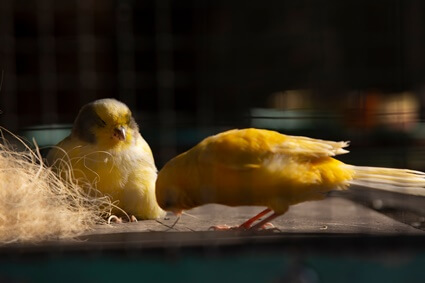
Nest Building
Female canaries ready to mate will build nests in anticipation of a new brood. They start by selecting a nesting site and then gradually gathering and adding nesting material until the nest is fully formed.
According to the Zoological Society of London, the nest-building activity normally peaks around 3-4 days before the female canary lays its first eggs.
Crouching
When female canaries prepare to mate, they start crouching on their perch. If the male and female are in the same cage, the female will crouch more often to signal the male to mount her.
Note that male canaries are eager to mate earlier than females.
If a female isn’t ready to mate or is uncomfortable with a specific partner, she may decline any mating prompts, which can cause the male to become aggressive.
In some cases, the male might even attack the reluctant female out of frustration, although this is rare, and you’ll spot signs of overt aggression before this point. If you do, separate them.
How To Prepare Your Canaries for Breeding
The lead-up to the breeding season is vital for canaries. During this time, they build up the strength and vigor needed to mate successfully and care for their brood and resulting hatchlings.
If your canaries aren’t physically prepared for breeding, they’re likely to produce infertile eggs. Even if they produce hatchlings, they won’t be able to care for the offspring and may even abandon them.
For this reason, it’s important to prepare your canaries before the breeding season commences:
Feed Your Birds Well
The breeding season is an energy-intensive period in a canary’s life, making it crucial to give your birds a diet high in calcium and protein in the weeks leading up to the mating period.
Plenty of Exercise
Exercise will help your canaries become physically strong and improve their stamina, which will help during the breeding and egg-laying phases.
You can encourage your canary to exercise by providing a larger cage, offering more perches, or allowing them to free-fly in an enclosed room.
Ample Light
Longer daylight hours (about 12-14 in particular) can stimulate canaries into breeding.
Ensure your canary pair can receive direct sunlight (with supervision) or use a UVB light to assist. This will also help them better metabolize vitamins, such as A and D, which can improve their health.
Choose The Right Cage
The most commonly used canary breeding cages have a divider in the middle. This allows the male and female canaries to remain in separate compartments while still being able to see and flirt with each other.
This allows you to monitor how well your canaries are getting along before they are paired for mating.
Both must be ready to breed before having physical contact with each other. If they’re paired up too soon, the male could attack the female canary if she refuses to mate.
Pick The Right Bedding
You can provide strips of paper towels, cotton, jute, or felt for nesting material. The female will use these materials to form her nest and prepare the eggs. If your canary is picky, you can offer her various types.
Once all those steps have been taken, wait until the pair both display their mating routines, such as singing, dancing, crouching, and nest building.
After this, you can remove the divider and allow them to begin mating.

